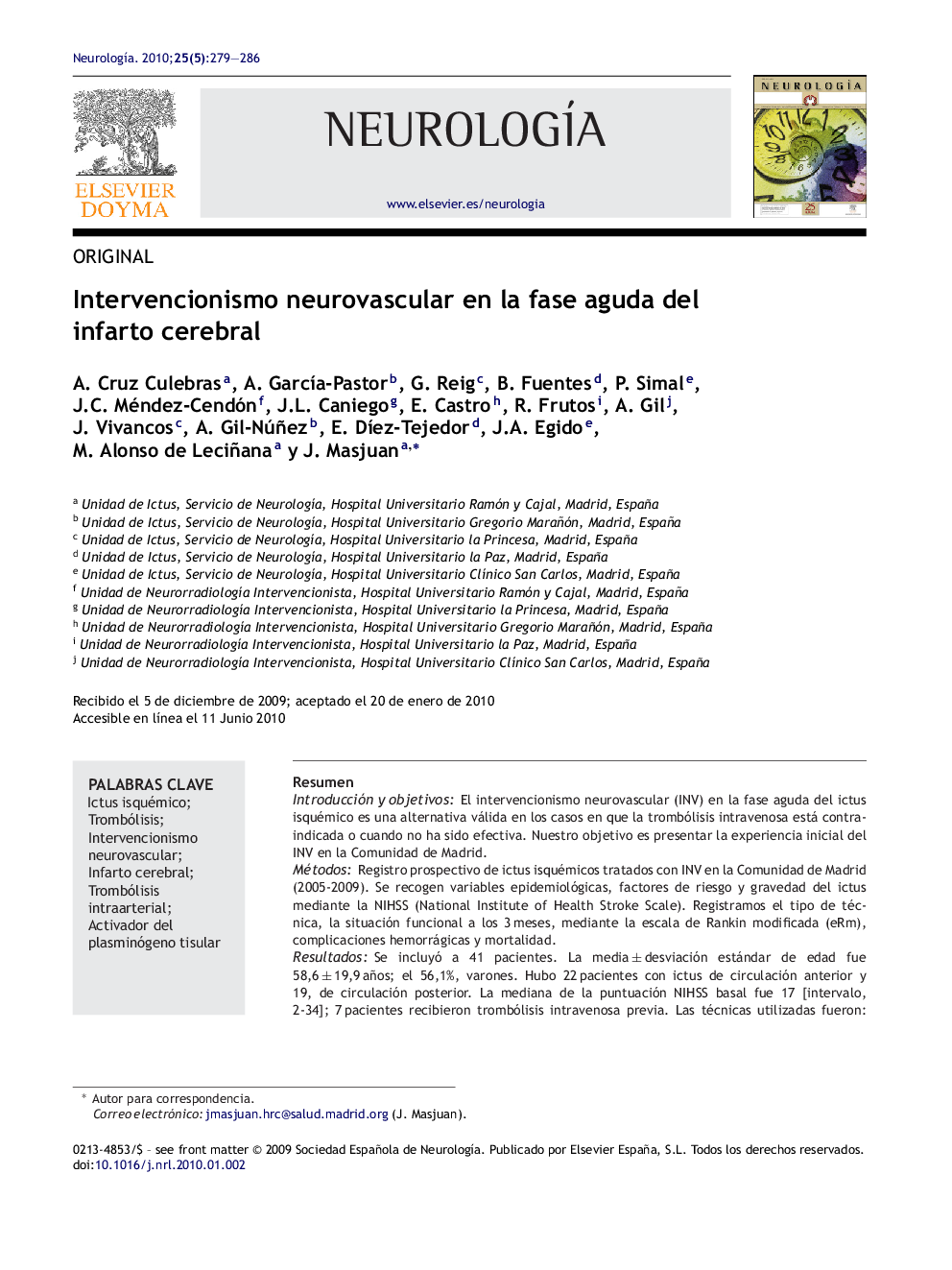| Article ID | Journal | Published Year | Pages | File Type |
|---|---|---|---|---|
| 3076237 | Neurología | 2010 | 8 Pages |
ResumenIntroducción y objetivosEl intervencionismo neurovascular (INV) en la fase aguda del ictus isquémico es una alternativa válida en los casos en que la trombólisis intravenosa está contraindicada o cuando no ha sido efectiva. Nuestro objetivo es presentar la experiencia inicial del INV en la Comunidad de Madrid.MétodosRegistro prospectivo de ictus isquémicos tratados con INV en la Comunidad de Madrid (2005-2009). Se recogen variables epidemiológicas, factores de riesgo y gravedad del ictus mediante la NIHSS (National Institute of Health Stroke Scale). Registramos el tipo de técnica, la situación funcional a los 3 meses, mediante la escala de Rankin modificada (eRm), complicaciones hemorrágicas y mortalidad.ResultadosSe incluyó a 41 pacientes. La media ± desviación estándar de edad fue 58,6 ± 19,9 años; el 56,1%, varones. Hubo 22 pacientes con ictus de circulación anterior y 19, de circulación posterior. La mediana de la puntuación NIHSS basal fue 17 [intervalo, 2-34]; 7 pacientes recibieron trombólisis intravenosa previa. Las técnicas utilizadas fueron: interrupción mecánica (26 pacientes), trombólisis intraarterial (26 pacientes), angioplastia/stent (5 pacientes), extracción mecánica mediante dispositivo MERCI (Mechanical Embolus Removal in Cerebral Ischemia) (3 pacientes). Se consiguió una recanalización parcial o total en 32 pacientes (78%). Un paciente presentó una transformación hemorrágica sintomática (2,4%). Al cabo de 3 meses el 53,6% de los pacientes eran independientes (eRm ≤ 2) y la mortalidad general fue del 19,5%.ConclusionesEl ictus isquémico es una emergencia médica tratable en las primeras horas. El INV es una alternativa terapéutica factible y útil en los casos de contraindicación o ineficacia de la trombólisis intravenosa.
Background and purposeEndovascular therapies in acute ischaemic stroke may offer benefits to patients that are not eligible for standard use of intravenous tissue activator plasminogen (iv t-PA) or when this is not effective. Our aim is to present the initial experience in with endovascular techniques in the Community of Madrid.MethodsWe present data from our registry of acute ischaemic strokes treated with endovascular re-perfusion therapies in five University Hospitals in Madrid (Spain) during the period 2005-2009. We recorded demographic data, vascular risk factors, risk severity with the NIHSS (National Institute of Health Stroke Scale), endovascular techniques, complications and mortality rates. Functional outcome and neurological disability at 90 days was defined by the modified Rankin scale (mRs).ResultsA total of 41 patients were treated with endovascular therapies. Mean age was 58.6 ± 19.9, and 56.1% were males. Of those 22 patients had an anterior circulation stroke and 19 had a posterior circulation stroke. Baseline NIHSS score was: median, 17 [range, 2-34]; 7 patients had previously received iv t-PA. The following endovascular techniques were performed: mechanical disruption (26 patients), intra-arterial infusion of t-PA (26 patients), angioplasty and stenting (5 patients), mechanical use of MERCI device (3 patients). Partial or total re-canalization was achieved in 32 patients (78%). Only one patient had a symptomatic cerebral haemorrhage. Three months after stroke, 53.6% of the patients were independent (mRs ≤ 2) and overall mortality rate was 19.5%.ConclusionsAcute ischaemic stroke is a potentially treatable medical emergency within the first hours after the onset of symptoms. Stroke endovascular procedures constitute an alternative for patients with iv t-PA exclusion criteria or when this is not effective.
